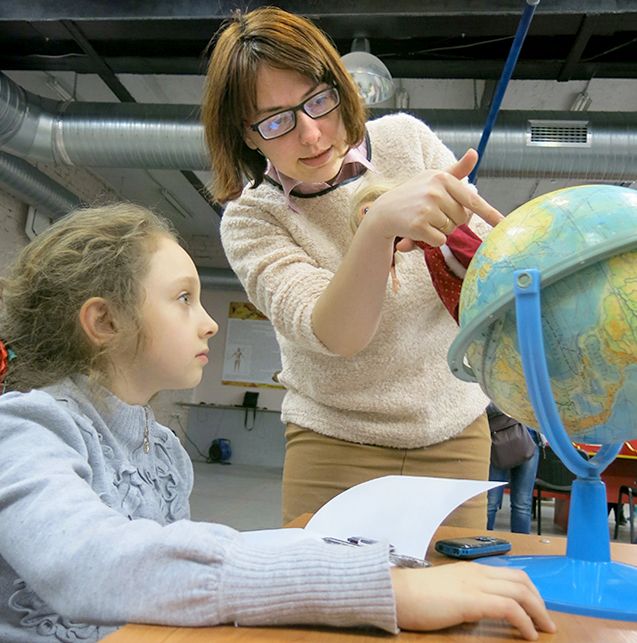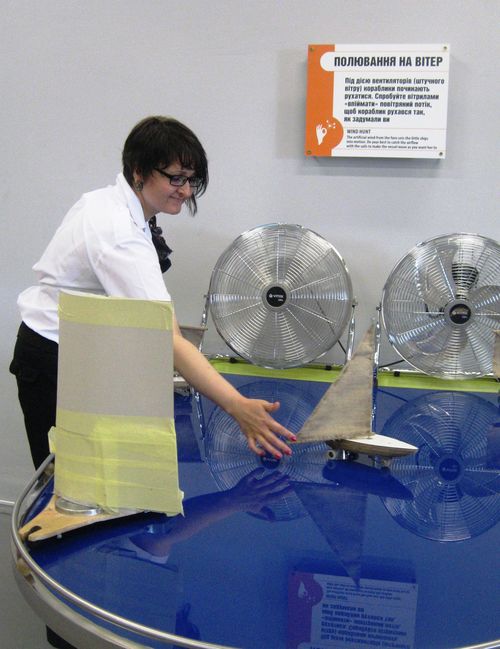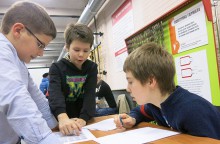It was a regular weekday, but having barely entered the Landau Center, I heard… sound of wooden pieces being knocked together. Two families including parents and several children were enthusiastically solving geometric puzzles, so immersed in it that they failed to notice anyone else’s presence nearby.
The puzzle table has become the most positive mini-playground in the Landau Center due to the variability of solutions to the problems it offers. Adults sometimes spend a long time in patient search for the only correct assembly pattern, as opposed to children who intuitively solve a logical problem without wasting even a second. After all, they have to learn and do so many more interesting things here!
HOW SCIENCE STOPS BEING “BORING”
For three years already Kharkiv has been offering everyone an opportunity to not just explore the world’s scientific achievements, but also to join the mysteries of science by taking a personal part in interesting experiments.
At the initiative of the Alumni, Faculty and Friends Association of Karazin Kharkiv National University, the Northern Building of one of the oldest universities of Ukraine has come to house the Landau Center science demonstration and education facility.
As its director Viktoria Kruhlova told us, the mission of this new exhibition venue, targeting all those who wish to spend their leisure time in pleasant, but also thought-provoking entertainment, was to encourage the revival of public interest in science (especially among children and young people) and create this country’s first public university intellectual leisure center for residents and guests of Kharkiv.
When creating this venue, Karazin Kharkiv National University drew on the best international experience, offered by the Exploratorium Museum of Science in San Francisco, US; the Copernicus Science Centre in Warsaw, Poland; the Museum of Science in Boston, US; the Experimentanium Museum of Popular Science and Technology in Kyiv; and the NEMO Center for Science and Technology in Amsterdam, the Netherlands.
“You are welcome to touch exhibits, do experiments, conduct research!” – everything is possible at the Landau Center. That is why science stops being boring and attracts interest from young people, they seem to be inextricably glued to gadgets and computers.

After all, the center’s exhibits are original instruments created by inventors, true heroes and lovers of science.
Look at the phenomenon of electricity, for instance. We treat it as something ordinary, since we have grown with it. However, the center’s employees offer young visitors and their parents a chance to become generators of electricity themselves by… riding a bike and pedaling! And then, a small electric “sun” will come to life on a special stand before one’s eyes. Even a small child can ignite it.
By the way, some parents have built such a turbo exercise bike at home. The mom pedals and simultaneously charges the phone.
Another exhibit is no less interesting, having three slide-tracks made of different materials: artificial grass, cloth, and wood. They allow one to study the friction force by observing the varying speed of a metal disk sliding on these surfaces, as well as to get acquainted with the basics of materials science.
“Do you remember that prosaic saying that goes ‘Science is around us?’” Kruhlova asked me. “However, how often do we notice its fruits? We strive to open people’s eyes to the fact that everything that surrounds us is the result of thought and work of the human genius. And speaking of competency-based approach to school education now being implemented by the Ministry of Education, the Landau Center’s exhibitions are precisely that, teaching kids things which they can use later in everyday life and research.”
INVESTING IN PEOPLE
As head of the Northeastern Research Center of the National Academy of Sciences of Ukraine Academician Volodymyr Semynozhenko remarked, as late as 20 years ago, most global research investment paid for new equipment and technology, 10 years ago the money was already being invested in new ideas or concepts, and now, new investments increasingly target human capital, which actually creates concepts and ideas, and then equipment and technology which ensure innovative development of the country in question.
According to forecasts made public at the 46th Annual Meeting of the World Economic Forum in Davos, the world is entering the fourth industrial revolution, better known as Industry 4.0. It is projected that new popular and high-demand occupations may include by 2020 those of neural robotic control interface designer, children’s robotics designer, composite materials engineer, and multifunctional robotic systems operator.
In principle, and however paradoxically it sounds, Ukraine has a unique chance to advance from the second wave of industrialization (which we sadly linger in) to the fourth one at once. Instead of introducing modern technology and production models which will inevitably grow obsolete, we can make a strategic move ahead of the curve and meet the new industrial era fully prepared.

VIKTORIA KRUHLOVA (PICTURED) NEVER TIRES OF REPEATING THAT REPRESENTATION AND PERCEPTION OF SCIENCE IN THE LANDAU CENTER IS INTERPRETED NOT STEREOTYPICALLY, BUT WITH A HUGE DEGREE OF FREEDOM
And here, apparently, Kharkiv has a very special role to play as a leading intellectual center of Ukraine. First of all, we are talking about its technical universities that produce experts in robotics and mechatronics as well as academic research institutes.
This writer has already seen computer-controlled production lines in Kharkiv’s leading factories. Yes, of course, they are still relatively few, but there are some.
Also, the structure of the national economy should be adjusted to reflect the changing production conditions, as should the human resources which need to possess scientific knowledge and experience and enjoy a degree of creative freedom, but that is another matter altogether.
According to Deputy Minister of Education and Science Maksym Strikha, the results of the Landau Center’s work will be felt already in five to ten years, when better-prepared and more creative young people will enter the technical, natural and mathematical sciences.
WHAT IS FREEDOM, BROTHER?
Kruhlova never tires of repeating that representation and perception of science in the Landau Center is interpreted not stereotypically, but with a huge degree of freedom, since it values the individuality of each visitor or organizer of the exhibition, their creative participation in the cause of education and the end result that often changes one’s understanding of science.
For example, the center saw participants of the final tournament of young physicists from Lviv, Kyiv, Rivne, Sumy, Kharkiv, Ivano-Frankivsk, and other cities of Ukraine coming there. Fresh from delivering scientific reports, these kids found themselves in a completely different dimension of scientific knowledge where science is presented not in theory but in practical applications, and where no one suggests the right solution, but everyone has to find it on one’s own.
For instance, one student from Lviv immediately went on to hold a workshop for his peers dealing with the Lissajous curves (incidentally, it was also the theme of his report during the physics tournament). The Lissajous curves, named after the French scientist who first studied them, are closed lines formed when two harmonic vibrations along perpendicular lines are superimposed. It sounds complicated and incomprehensible, isn’t it? But after his mini-lecture, every visitor drew their own Lissajous curves... with sand.
Methods of interactive learning and education are very actively discussed in the scientific community.
“We once did archeology with kids,” Kruhlova gave another example. “Our colleagues from the university’s research laboratory of the German-Slavic archaeological expedition brought to the Landau Center a box full of shards belonging to all kinds of pottery, which, incidentally, were 1,500 years old. It was a kind of by-product of archeological excavations. Kids took the most beautiful, from their perspective, shards from the box, drilled holes through them under the supervision of our staff member, and ran burlap threads through these holes, thus making pendants. They called them ‘good luck pendants,’ which are 1,500 years old.
It is an excellent example of interactivity. In addition, the whole performance was actually made from nothing. But still, how strong the kids’ emotions were at the moment of obtaining the result! And what a wonderful educational effect it had, inspiring respect for history in general, the history of our people in particular, and hope for good luck that a fragment of an ancient artifact will surely bring!
So, I want to emphasize once again: do not be afraid of experiments, and remember that avoiding stereotypes and moving forward works. After all, the most valuable part of our work is the process of creation and creativity, which is the highest expression of freedom.”







